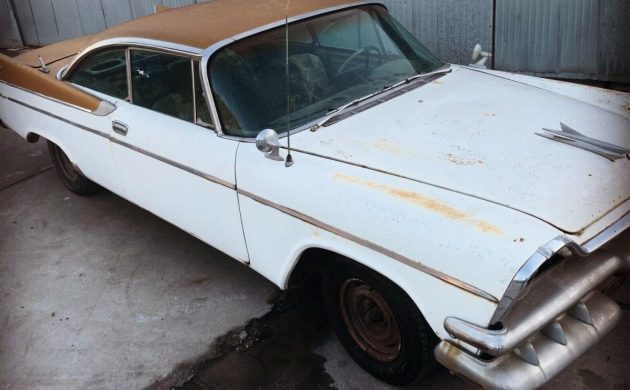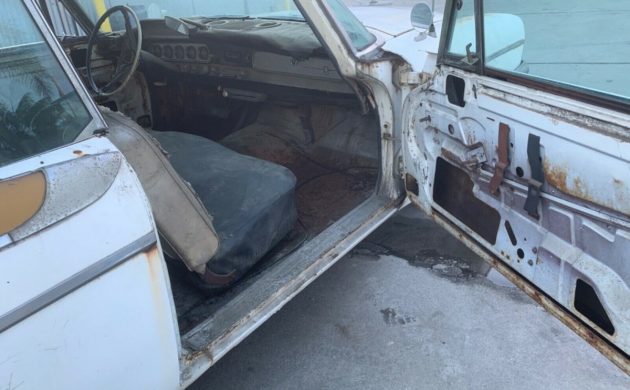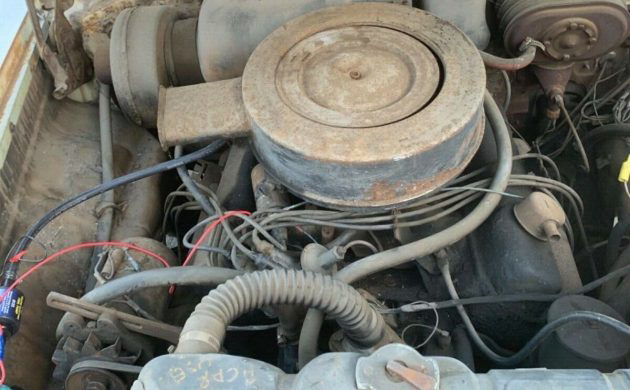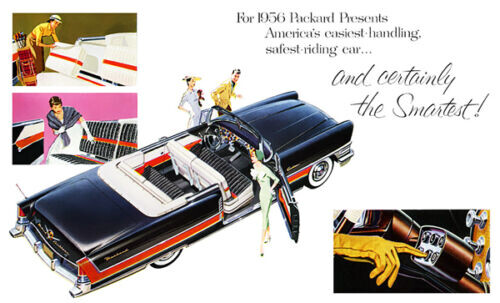Solid Project: 1958 Dodge Custom Royal Lancer
Vehicles designed by Virgil Exner can be accused of being many things, but the word “subtle” is not one that springs instantly to mind. Nowhere is this better demonstrated than in the 1958 Dodge Custom Royal Lancer, a vehicle with enough fins and chrome to satisfy most 1950s motoring enthusiasts. Barn Finder Ikey H spotted the Dodge for us, so thank you so much for that Ikey, and keep them coming. It is located in Harbor City, California, and has been listed for sale here on eBay. The owner has set a BIN of $9,900, but if you’re feeling brave, the option is available to make an offer.
The first thing that I noticed with the Dodge is just how solid it appears to be. There is some rust appearing around the rear window. The rest of the panels appear to be clean, with no signs of any rust of any significance in the rear quarter panels, rockers, lower fenders, or doors. The floors carry a good coating of surface corrosion (as does the trunk pan), but apart from a soft area in the front floor on the passenger side, there seem to be no issues of any significance. The owner provides some photos of the Lancer’s underside, and the frame also looks to be rock solid. The vast majority of the tinted glass looks good, although the windshield sports some pretty nasty cracks. However, a quick search showed that replacement windshields are readily available, and will cost around the $420 mark. It looks like all of the external trim and chrome is present, and while the bumpers and a few other items will require a trip to the plater, the remaining trim looks like it would respond well to a bit of work with some polish. Some of the lenses for the tail-lights are also dmamaged, but I was suprised by just how easy replacemnts are to locate.
Being the range-topping Dodge of 1958, the Custom Royal Lancer would have been built with quite a plush interior. Those days have long gone, and a full restoration of the interior will be required. The most awkward part of this process will be the fact that the door trims are missing, so replacements will need to be sourced. Having said that, a bit of a search revealed a number of companies that can supply complete interior trim kits for the 1958 Custom Royal Lancer, but they don’t directly quote prices. It seems to be strictly a price-on-application basis only. If carpet prices are any indication, then the trim might not be too bad, because a full carpet set can be found fairly readily for under $300. Even so, items like the wheel and dash pad will also require replacement, and the companies that I looked at don’t extend to that sort of service. So it looks like a parts search could be on the agenda for the next owner.
The Dodge is a big and relatively heavy car, so the fact that it can accelerate from 0-60 in 8.2 seconds and cover the ¼ mile in 16.1 seconds would suggest that it packs something pretty decent under the hood. This is correct, with the 361ci V8 nestling in the engine bay producing 305hp. Being a luxury car, it also features a 3-speed TorqueFlite transmission, power steering, and power brakes. It isn’t clear just how long the Dodge has been inactive for, but it appears as though the engine might be in reasonable health. The owner states that it will fire up using starter fluid and that the transmission seems to select gears. Things look pretty grotty and dirty under the hood, so a good clean is going to be the first order of business. Once this is done, it sounds like there is a real possibility that a full service, a fluid change, and a fuel system flush and clean might have things operating back at their best. Of course, there are bound to be plenty of items, such as the brakes, that will need attention. However, it does appear as though the Dodge is going to prove to be in generally sound mechanical health.
This Dodge Custom Royal Lancer is one very distinctive car, and its styling leaves little doubt about what era it hails from. It would appear that the popularity of 1950s classic cars is showing no signs of diminishing, and it seems that when it comes to vehicles with fins, bigger is definitely better. With that in mind, it should be no surprise to learn that nicely restored examples today will easily sell for prices in excess of $50,000, although sums of $60,000 or more are not unheard of. Given how little rust there is in this vehicle, that would seem to make it a pretty sound candidate for restoration.
Auctions Ending Soon
 2006 Ford Mustang Saleen S281 SCBid Now4 hours$16,000
2006 Ford Mustang Saleen S281 SCBid Now4 hours$16,000
 2002 Subaru Impreza WRXBid Now3 days$333
2002 Subaru Impreza WRXBid Now3 days$333
 1975 Chevrolet Corvette ConvertibleBid Now3 days$3,000
1975 Chevrolet Corvette ConvertibleBid Now3 days$3,000
 1964 Ford F-100 Camper CustomBid Now3 days$2,000
1964 Ford F-100 Camper CustomBid Now3 days$2,000
 2006 Jeep Wrangler SportBid Now5 days$10,500
2006 Jeep Wrangler SportBid Now5 days$10,500










Comments
Just not sure what to do with this stuff these days. Re-chroming alone will cost thousands. It is, or was a fantastic car, but again ( and again) cars like this have to be nicer, and unless you have a profound attraction to one, for what you’d have into this, ( and going through several body shops that throw in the towel), you’re just better off finding one original, or older restoration that just needs TLC, than this.
The starting price + Restoring this car will end up costing more than it’s final value…
Oh, of course. Resale value is the only reason to restore a car. Not because you, you know, want one, or anything.
No, it is not the only reason but with the rarity of the car parts would be either almost impossible to find or extremely expensive. Even for people like myself that enjoy and do the work I can’t see putting twice or more into it that it will be worth when restored even if you plan driving it forever.
Tim, I own several classic cars, and despite the love of each, chose carefully the necessary resources into restorations not becuase I was looking to flip for a profit, but becuase it’s just plain stupid to build a car well-beyond it’s market value instead of buying one that has been already restored. The problem is many people get in over their heads and when it’s time to bail out, they think the value is everything they put in, despite what the marketplace value is for the car.
If you’re putting in 2 or 3 times the value of the car you “love” please don’t say it’s worth more than the marketplace value because you had to pay more to get it to a Strong #2 or to a #1 condition. I’ve seen that all too often with people who say they weren’t concerned about resale when they restored their car…
DartDen, you are absolutely correct.
Many of the people that make the argument that value shouldn’t be a factor are among the loudest when it comes to complaining about overpriced projects and how the market is in a bubble. They can’t have it both ways. Cars such as this will be hit much harder than popular musclecars if the market eventually tanks.
Steve R
I’ve seen in recent years a fairly strong number of restored `57-`58 Dodge Custom Royals, and the end results appear to be VERY much worth the cost. OK, so this is not a “Super D-500” 2x4bbl. Hemi V8; that doesn’t take away from this at all. From the toothy grin up front to the beautiful two-toning, these underdogs are real eye-catchers at shows. Plus, the MoPar club has go-to’s that specialize in various vintages of models, making info alot easier from those that own & have worked on a particular model. I wonder if the seller has the missing door trim panels, etc?
My parents had the 4 door hardtop version of this car and despite this, it was
still an attractive car. Ours was pink and
white with a very loud pink, black, and white interior. I seem to recall that ours
had a 325 Red Ram hemi for power too.
It also had the 2 rear fender antennas
for the radio as well. Dad added a 102
inch whip antenna to the mix for his CB
radio, and that made the car look like it
came from outer space. In fact, there
was one Sunday that he scared the crap
out the congregation of the church we
were attending then. The pastor was
telling the crowd that one day the Lord
would speak unto them. And just after
he said that, Dad’s voice came over the
church’s sound system loud and clear!
It seemed that the signal from the CB
radio “bled” over the PA system in the
Sanctuary and caused that “devine”
moment much to my Mom’s embarrassment. Me, I thought it was
pretty cool, but after we adjusted the
TVI trap at the rear of the PA system
in the church, there were no more “divine”
moments like that again. Great car! Ahh
the memories!
Need to do you’re research more thoroughly, it is a 1958 Custom Royal, but someone has installed a 1957 front clip, engine will be a 350ci, 361ci was D500 spec, dash pads are available, and steering wheel can be restored by a few different companies.
Looks more like a 57 to me. Only has single headlamps.
The position of the inside rear view mirror makes this a ’58. The front clip might be from a ’57.
It’s called, for the love of the hobby!
The love of a fine, classic automobile.
I’ve seen these comments over and over again here on Barn Finds and it always makes me wonder, why are you here? If money is your only concern (return on your investment) why are you here? Play the stock market if money is your only concern.
Those of us who have a love for these old beauties, keeping them alive for future generations is our concern.
Does this fall under “politics” or “personal attacks”? I hope not. Just venting my opinion as certain others vented theirs.
Are there any Hot Rodders on here? Not everything needs to be “Restored”. Just fix it and drive it! It’s a hobby for sure and if “messing it up” by not restoring it, so be it. It’s better than sending it to the crusher!
I’m not positive about the year, I thought the 58’s had the option of 2 or 4 headlamps as some states hadn’t made the quads legal yet. This is a pretty solid looking Dodge, and I think it would make a nice project for someone who can do at least some of the needed work. I’ve done several restorations that put me upside down just because I liked the car, or because I had some connection with it. It’s like buying a new car, you drive it, enjoy it. It deprecates, after you’ve enjoyed it for awhile you let it go and lose some money. So what!
The 57’s had single headlights, due to states not approving quads yet. A few were built with quad headlights, I’m told. All the 58’s had quad lights.
These cars were serious rusters so finding one that’s not completely rotted out is fairly unusual. This one seems like a pretty decent starting point for a restoration but as noted by a few comments already, it may be a costly one. The styling on the Chryslers of the period was amazing and restored examples are stunning. Materials, parts and chroming won’t be cheap but if you can do the bodywork and paint yourself, you may be OK when it’s time to let it go. I would like to think these cars will continue to increase in value, too; you’ll certainly never see their like again.
This is a cool car that you just don’t see much of anymore!!! Not my style personally but it’s a big American finned cruiser!!! I’ve always built my own cars because it’s been easier for me to keep dropping smaller amounts of money over a longer period of time then dumping a large sum all at once!! I also get to personalize it to some degree!!! Not saying it’s for everyone but it’s always worked for me!!!
Seller says he BELIEVES it is a 361! Not for sure. I’ve heard that phrase so many times it’s getting irritating. Buy one already done, yeah in this case that would be about $50,000 Most I have to believe do NOT have $50,000 cash laying around to plop down tomorrow to drive one away. Most would put up the $10,000 in this case and over a period of 2-3 years invest the rest. Although if you are going to get bent over and pile $100,000 to some “restoration shop” then by all means take out a second mortgage and park one you find at one of the thousands of “collector” car joints in your garage for half of that $100,000. There it will sit 75% of it’s life with you collecting dust and be asked by the “wife” why you’re paying for this thing to sit and collect dust…. Hopefully if you find one for $50,000 “restored” it won’t be some pig with loads of lipstick on it covering a rust bucket. Good shops can hide a lot from the average Joe Consumer who want to play “car guy” this weekend at some cruise or show. Yeah, good luck I say.
Good shops don’t hide things.
The 350 was only available in 1958. Because it was a one year only motor, it is not as well known as the 361.
Sooner or later the market will tank. That’s inevitable. But, does that mean that cars like this ’58 Dodge is not worth restoring? Only muscle cars because they will retain their value?
If I never joined this hobby, I’d probably be a millionaire by now, not spending all that money on cars I loved, enjoyed and restored. But I did join the hobby. I do have a love for most vehicles.
In the early 2000s I purchased a 1970 Buick Riviera for $600. I put $5000 into it. Drove it. Enjoyed it. Then had to sell it. I got $600 for it. A loss of $5000, but in my book it wasn’t a loss. The car is drivable and enjoyable and someone will pick up where I left off and continue to restore it.
Granted, $5000 isn’t a lot when you’re comparing a $100,000 concores restoration, but the principal is the same.
HUGE RED FLAG!
The car was bought from a tow yard and will be sold on a bill of sale.
The car has been out of the DMV system for years, so there is probably an owner out there that has claim to the car.
The tow yard did not provide any lien sale documents so the previous owners were never notified of the sale by the tow yard.
The VIN would have to be checked to see if it was reported stolen at some point.